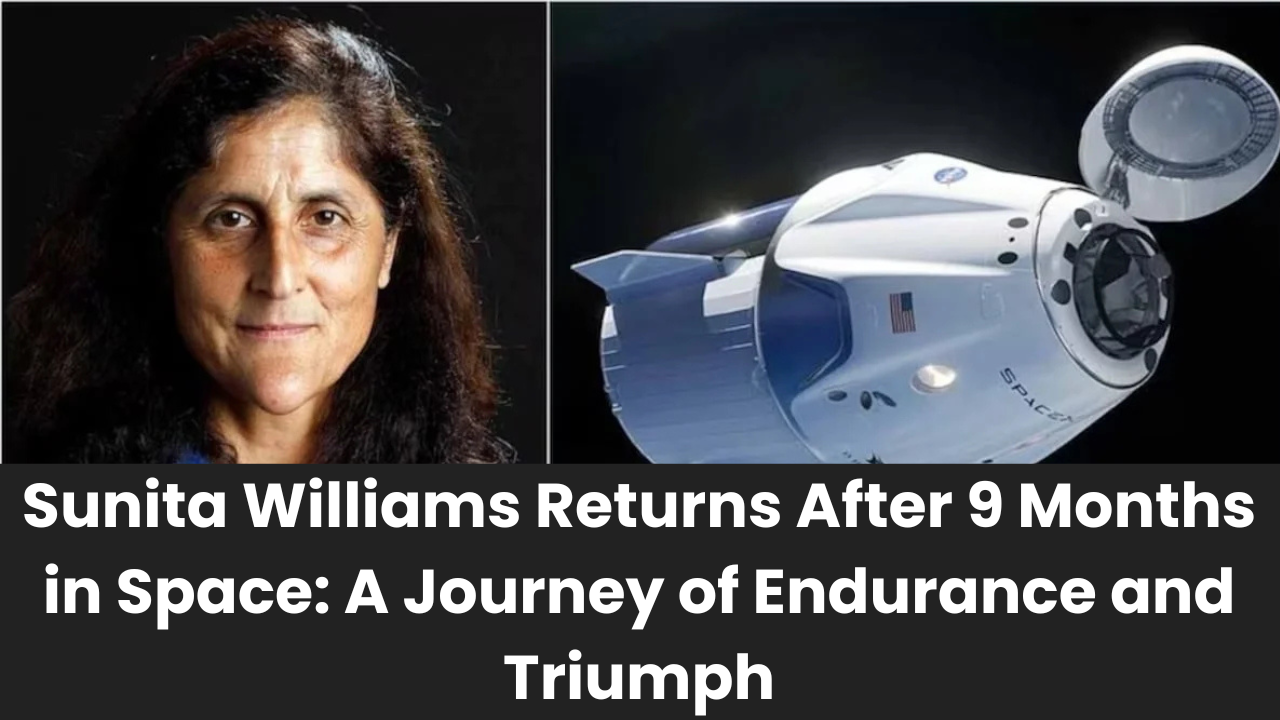Sunita Williams Returns After 9 Months in Space: A Journey of Endurance and Triumph
- Date

-
 admin
admin
🔹 Introduction
NASA astronaut Sunita Williams and her crewmate Butch Wilmore have successfully returned to Earth after spending an unplanned **nine months aboard the International Space Station (ISS)**. Initially, their mission was scheduled for **just eight days**, but due to technical issues with their original spacecraft, they remained in space for **286 days**.
On Tuesday, March 18, 2025, their **SpaceX Dragon Freedom capsule** splashed down safely near **Tallahassee, Florida**, at **5:57 PM ET (3:27 AM IST, Wednesday)**. They were accompanied by fellow astronauts **Nick Hague** and **Aleksandr Grebyonkin**, who had arrived at the ISS in December as part of a separate rescue mission.
Once their **17-hour return journey** ended, recovery teams aboard the **SpaceX ship MEGAN** helped the astronauts out of their capsule. Despite enduring nearly nine months in microgravity, the crew smiled and waved at the cameras before being carried away on **stretchers** for routine medical evaluations.
🔹 From 8 Days to 9 Months: The Unexpected Extension
Sunita Williams and Butch Wilmore launched aboard **Boeing's Starliner** in June 2024 as part of NASA's **Commercial Crew Program**. Their mission was intended to be a **short test flight**, but technical issues with the **Starliner's propulsion system** forced them to remain on the ISS.
The **Starliner capsule** was deemed unsafe for their return journey and was sent back to Earth without its crew in **September 2024**. This unexpected malfunction extended their mission by several months.
NASA and Boeing collaborated with **SpaceX** to plan the crew's rescue. In **December 2024**, astronauts **Nick Hague** and **Aleksandr Grebyonkin** arrived at the ISS aboard the **SpaceX Dragon Freedom capsule** as part of the rescue effort.
🔹 The Historic Return
After nearly **nine months in space**, the astronauts finally returned aboard **SpaceX’s Dragon capsule**. Their splashdown in the **Gulf of Mexico** was met with relief and celebration. Recovery teams swiftly helped the crew out of the capsule, where they appeared in good spirits despite the physical toll of their extended mission.
The astronauts were then carried away on **stretchers** for standard post-mission medical checkups. This is a common practice for returning astronauts, as extended exposure to microgravity affects **muscle strength, bone density**, and cardiovascular health.
🔹 Key Achievements During the Mission
Throughout their **286-day stay**, the crew performed significant **scientific experiments** and technology tests. Their contributions included:
- Orbiting Earth 4,576 times.
- Traveling over 121 million miles (195 million km).
- Conducting **over 50 experiments** on microgravity, biology, and material science.
- Testing new technologies for future **deep-space missions**.
🔹 Sunita Williams' Legacy in Space
With this mission, **Sunita Williams** has now spent a total of **608 days in space** across her three spaceflights, making her the **second most-experienced US astronaut** in terms of space time. She is surpassed only by **Peggy Whitson**, who holds the record with **675 days**.
Williams’ contributions to space exploration include numerous **spacewalks, scientific experiments,** and collaborations with international agencies. Her dedication continues to inspire future generations of astronauts.
🔹 Challenges of Prolonged Space Travel
Spending nearly **nine months in microgravity** poses several physical and psychological challenges. Upon their return, the astronauts experienced:
- **Muscle atrophy** and reduced bone density.
- Changes in **cardiovascular function** due to fluid redistribution.
- Possible vision changes from fluid shifts.
- Psychological effects from prolonged isolation and confinement.
The crew will now undergo a **45-day rehabilitation program**, including physical therapy, nutrition plans, and regular health assessments to recover from the effects of long-term space exposure.
🔹 NASA and SpaceX's Triumph
The mission’s success highlights the **reliability of SpaceX’s Dragon capsule**, which safely brought the crew back. NASA praised **SpaceX’s role** in ensuring the astronauts' safe return, marking another significant milestone in **commercial spaceflight**.
The safe return also carried political significance. Following the splashdown, the **White House** credited **President Trump** for supporting the mission, with a statement that read:
“PROMISE MADE, PROMISE KEPT: President Trump pledged to rescue the astronauts stranded in space for nine months. Today, they safely splashed down in the Gulf of America, thanks to @ElonMusk, @SpaceX, and @NASA!”
🔹 Future of Space Exploration
The mission's success paves the way for **future space exploration**, including missions to the **Moon and Mars**. The crew’s extended stay provided NASA with valuable insights into the **effects of long-term space travel**, which is crucial for future **deep-space missions**.
NASA plans to continue collaborating with **SpaceX, Boeing, and international partners** to develop more **reliable spacecraft** and expand human presence in space.
🔹 Conclusion: A Mission of Resilience
The return of **Sunita Williams** and her crew is a **triumph of human resilience** and technological innovation. Their **286-day journey** demonstrated the **adaptability, courage, and determination** of space explorers.
As the astronauts begin their **recovery process**, the world celebrates their mission as a **symbol of perseverance and exploration**. Their story continues to inspire space enthusiasts and scientists alike.
Learn more about technology: What is Machine Learning?
```